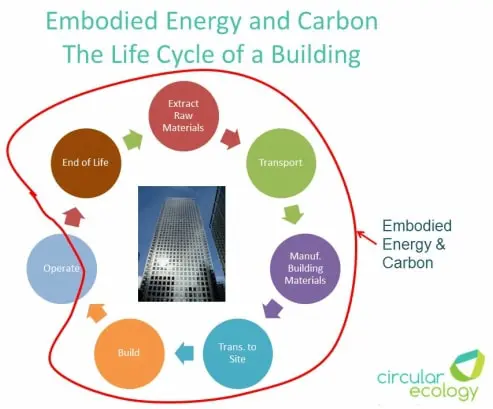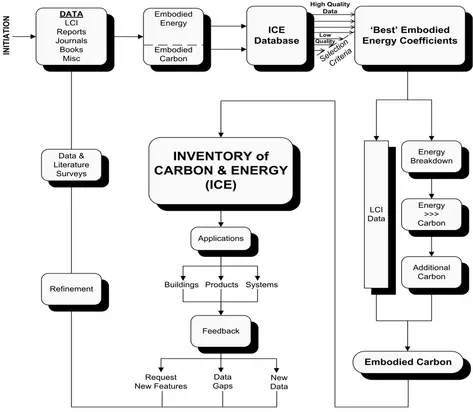Embodied Carbon - The ICE Database
Embodied carbon comes from the consumption of embodied energy consumed to extract, refine, process, transport and fabricate a material or product (including buildings). It is often measured from cradle to (factory) gate, cradle to site (of use), or cradle to grave (end of life). The embodied carbon footprint is therefore the amount of carbon (CO2 or CO2e emission) to produce a material.
It is a topic of rising importance. In fact, it is normally possible to reduce the embodied energy and carbon of a building or construction project by 10-20% without adding to the build cost. What’s more, embodied carbon is often 20-50%, or so, of the whole life energy and carbon of a building, i.e. when operational carbon emissions are considered.
The embodied carbon life cycle of a building can be expressed on a single diagram, as below.

So if you’re not looking at the embodied carbon of your project, then you are missing out on a valuable opportunity. This is where the Inventory of Carbon & Energy database can help. The ICE database is a useful source of embodied carbon data and is available for free from this page (fill in the form below).
Download your free embodied carbon database - over 30,000 users
The ICE Database can be downloaded for free by submitting the form below, which takes you to an ICE download button.
About the ICE database
The Inventory of Carbon and Energy (also known as the ICE database) is an embodied carbon database for building materials which is available for free on this page. Our founder, Dr Craig Jones, created the ICE database in his former role as a researcher at the University of Bath whilst working for Professor Geoff Hammond, at the Sustainable Energy Research Team (SERT).
The ICE database originally contained embodied energy and embodied carbon factors. However, since 2019 embodied energy factors are no longer included. The data in the wider literature, which the ICE database relies upon, generally no longer reports the embodied energy of construction products. Instead, embodied carbon has become the main metric. Carbon emissions give a better indicator of the contribution of that energy to global warming and climate change.
In total, the ICE database has been downloaded by over 30,000 professionals from around the world and it appears in countless reports, journals, books, lectures, embodied energy and carbon footprint calculators, and more.
It contains data for over 200 materials, broken down into over 30 main material categories, such as:
- Bricks
- Cement
- Concrete
- Glass
- Timber
- Plastics
- Metals
- Minerals and stone
- Many more…
The energy data provides the energy consumed to make a building material. This then gives rise to embodied carbon emissions, contributing to global warming and climate change.
Creating an embodied energy and carbon database
The ICE database was created from a large review of the literature. The first version was released in 2005 and has been updated periodically. The diagram below shows how the database was created.

Latest version
The latest version of the ICE database is:
- ICE Database V3.0 – 10 Nov 2019
- ICE Cement, Mortar and Concrete Model – V1.1 Beta – 28 Nov 2019
- ICE Database Machine Readable V3.0 Beta – 10 Nov 2019
Check back here in the future to make sure that your version is the most up-to-date.
Please connect with us through LinkedIn, Twitter, or by sharing this page.
Essential Carbon Footprint Training Course Updated
Circular Ecology have recently completed updating their Essential Carbon Footprint Training Course. The e-learning course [...]
Apr
Hiring – Senior Sustainability Consultant
Join Circular Ecology. An opportunity is available for an enthusiastic and dedicated sustainability professional at [...]
Feb
Have a Very Green Christmas
For many people, Christmas is a time of joy and celebration, for sharing gifts and [...]
Dec
Circular Ecology Support the Launch of the Built Environment Carbon Database (BECD)
The Built Environment Carbon Database (BECD) is envisioned to become the main source of carbon [...]
Oct




